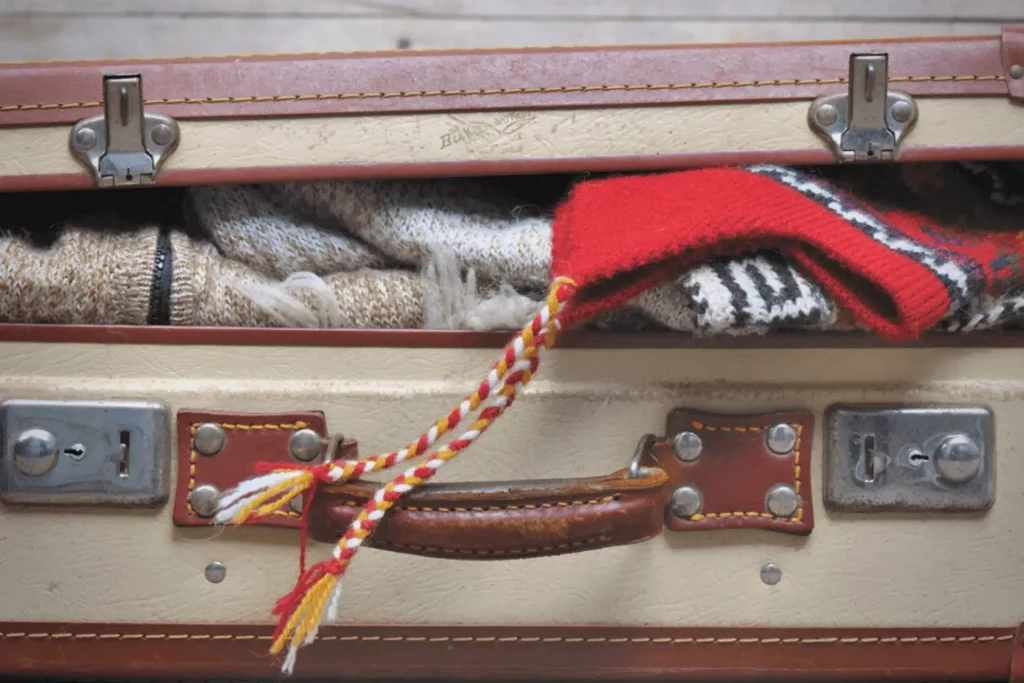When traveling, getting chilly or wet is the last thing you want to be concerned about when you’re on the road. To ensure that you remain warm and dry no matter what the weather throws at you, you must pack the gear to keep you warm and dry.
Natural water resistance and heat regulation make merino wool an excellent material for travel garments, and it is especially useful for winter travel. Learn more about merino wool in this blog post and how to keep warm and dry when traveling.
Remember to take a few things made of merino wool for your next vacation when packing your baggage. In addition to being naturally water-resistant, merino wool is an excellent fabric for travel garments since it has the following characteristics:
- It has a thermal-regulating function.
- Allows for easy breathing.
- It is portable and lightweight.
- Sturdy and long-lasting
Table of Contents
The Origins of Merino Wool:

Spain was the first place where merino wool sheep were raised, and Australia was the first place they were brought. When Australian farmers improved the quality of their sheep’s fibers via selective breeding, the fibers grew even finer.
Nonetheless, it wasn’t until the 1920s that the fine wool jerseys had their first major break in the fashion industry when Coco Chanel created a garment out of the material. Designers and woolgrowers are now collaborating to bring consumers closer to the natural advantages of this amazing fabric by educating them about it.
What Is Merino Wool Fabric, and How Does It Differ From Other Types of Wool?
You are packing for a trip may be a time-consuming process requiring making some difficult decisions. You have eight of your favorite travel shirts, but only one place for four of them.
You may not be able to predict when and where you will be able to do laundry when traveling, but that is part of the joy and unpredictability of travel!
Do you pack more clothing so that they will last longer between washing, or do you bring fewer and say “fuck it”? If your itinerary includes stops in icy mountains and warm beaches on the same trip, do you try to prepare for all seasons and wind up with a massive, overweight suitcase?
On the other hand, Merino wool may answer many of your packing concerns. It is, without a doubt, one of the greatest travel textiles available today. When it comes to freshness, packing one Merino wool t-shirt is comparable to carrying five cotton shirts in terms of volume.
Because it is lightweight and breathable in the heat and insulating in the cold, you won’t have to wash it every time you put it on, and we nearly promise that it will become your favorite travel shirt—meaning you’ll only need a few of them.
If you choose the best brands, it will cost you a lot of money, but the benefits of the material are well worth it… as long as you take proper care of it!
What Is It About Traveling in Merino Wool Apparel That Is So Appealing?

Merino wool clothing should be at the front of your packing list since it’s as near to magic as you’re going to get when it comes to keeping warm and comfortable.
First and foremost, because Merino wool travel gear is lightweight, you may carry fewer clothing items when you opt for it. The magic occurs because the fibers of the material alter in response to changes in temperature.
The wool fibers crimp and flex when cold, allowing air to be trapped between them, providing insulation. While wearing Merino wool in warm weather, your skin will remain cool and dry since the wool quickly absorbs perspiration.
Second, merino wool clothing is well-known for its wrinkle-resistance and elastic properties. As long as you take proper care of them, they will continue to look wonderful for many years to come. Merino is also naturally antibacterial, which means it is odor-resistant, which means you won’t have to wash them as frequently as you would with other fabrics.
Third, you should be aware that wearing merino wool travel gear can help to give natural Sunblock against the sun while on the road. Clothes made of merino wool have a Uv Protection Rating of around 40 or more, greater than cotton clothing, just 5. This number indicates that Merino wool can prevent roughly 97 percent of UV radiation from reaching the skin.
Furthermore, you should know that Merino wool is a long-lasting and environmentally friendly material. Merino wool is a natural and ecologically beneficial fiber that is biodegradable and will decompose in the environment approximately 1-5 years after being harvested.
In conclusion, hiking enthusiasts should invest in some Merino wool apparel for their upcoming expedition — it is the best addition to their hiking gear.
It is critical to have a good base layer for your journey to keep your body temperature balanced, and here is where Merino wool travel apparel truly excels. Merino wool is a preferred foundation layer because of its airy and natural fibers and is odor-resistant, quick-drying, and soft.
The garment’s lightness makes it a good match for thick coats and overshirts in cold weather, and it may be worn by itself in warm weather.
What Is the Difference Between Merino and Other Types of Wool?

Merino wool is the greatest form of wool since it is soft, odorless, and breathable. It is also the most expensive. Individuals with sensitive skin or adverse reactions to other types of fibers such as acrylics would appreciate this product (which can cause irritability). As a bonus, it does not pill as readily, allowing you to remain comfortable throughout the day!
Merino Wool for Travel:
Merino wool is an excellent travel cloth since it is adaptable to various situations. Every characteristic you require when traveling happens to be a strength of merino wool.
Although merino clothing is an investment, you will easily receive your money’s worth on a vacation if you use it often. Your merino wool clothing will keep you warm and dry in various conditions. It also manages moisture efficiently.
The merino wool may be worn more than once between washings without smelling bad. The general public seldom believes in the anti-odor characteristics of merino wool. They appear to be far too good to be true. You may wash your wool in the sink with a fast hand wash and allow it to dry overnight if you need to.
When I’m preparing for a vacation, even one that may last a week or more, I never carry more than three pairs of merino wool socks. To get the most mileage out of each pair, I plan to wear them at least three times each and wash them while on the road trip. If you’re prepared to travel with only one or two pairs of merino socks, you may perhaps travel for an unlimited period.
Finally, merino is a lightweight fiber that is simple to transport. Even though they are lightweight and packable, I never pack my merino shirts since I always wear one as my travel day attire.
Because it performs on par with most synthetic textiles while being natural and ecological, merino wool is referred to as “nature’s performance fabric.”
Is Merino Wool a Good Insulator?
When it comes to staying warm throughout the winter, insulation is essential. Many materials may be used to insulate, but wool is frequently used in conjunction with others to provide the most warmth.
Wool from the Merino sheep! It has several excellent characteristics, like being permeable and very seldom retaining body heat once it has passed through your skin, which means you’ll be comfortable and cozy all day without feeling too hot or chilly.
The Best Merino Wool Clothing:

All merino wool is not made equal. Wool mixes and 100 percent merino wool are available on the market, and they are available in a variety of costs and quality levels. I know this since I’ve tried a variety of different brands. I’ve purchased merino socks that have lasted me for several years. However, I’ve also purchased shirts that appeared like Swiss cheese after only a few washes and wear.
There has been an explosion of merino apparel and accessories firms and products during the last several years. Several of them are not introducing anything fresh to the market. They’ve only recently discovered that if the product has the word “merino” in the name, you can get a lot of money.
On the contrary, we trust the well-established companies that have demonstrated their worth through time. We also look to the newer generation of businesses introducing innovative ideas and high-tech items to the market.
Advantages of Merino Wool: The Best Clothing?
Many travel goods are created from this magic fabric, including socks, shirts, sweaters, hoodies, and even undergarments. But what is it in this fiber that makes it so remarkable, and why is it so good for travel?
Natural Antimicrobial Properties:

Merino wool’s antimicrobial properties are a fancy way of expressing that it inhibits the growth of odor-causing bacteria due to its excellent moisture regulation. This means that you won’t have to wash it as frequently as otherwise.
Comfortable and Soft:
Merino wool is the finest wool fiber available, making it far superior to the jumper your grandmother crocheted you for your birthday a few years ago. It is also hypoallergenic, which means you are unlikely to experience any skin sensitivities due to using it. Furthermore, it is inherently static resistant.
Quick Drying and Sweat Wicking:

Because the cloth wicks away moisture, the germs that cause the odor don’t have the wet environment required to grow.
Wearing your Merino wool t-shirt in the desert, on the slopes, or at the gym will ensure that you stay dry and odor-free all day. After all, your clothing will become dirty anyway…you should still take a shower.
Natural Elasticity:
If your items are properly cared for, they will not stretch out or lose their form! According to the manufacturer, the fiber can be stretched 30,000 times without being harmed because of the inherent crimp in the fiber. We haven’t tried it out ourselves, but perhaps we can enlist the help of an intern or something to do so.
Natural UV Protection:

Because of its inherent UPF of 40+, merino wool can protect your skin from the cancer-causing rays of the sun that we all adore. A UPF of 40 indicates that the product will prevent around 97 percent of UV rays from entering your skin AND that you will be able to apply less of that chemical-laden sunscreen.
Believe it or not, polyester provides nearly the same UV protection as cotton, but a soft cotton T-shirt has a UPF of 5, which means it blocks around 20% of the sun’s rays.
Biodegradable:
Nothing lasts forever, but when you retire your garments, you can rest assured that your merino wool goods will not be rotting in a landfill for an extended period.
Because the fiber is constituted of keratin, the same protein that makes up our hair and skin. It will naturally decompose and return to the ground after 1-5 years of being harvested. Synthetic fibers, such as nylon, deteriorate over 30-40 years.
Frequently Asked Questions:
Is Investing in Merino Wool a Good Investment?
Yes. I consider myself a minimalist in clothing, and I’m constantly looking for the best-performing options, particularly for my travel wardrobe.
What is it that Merino wool is particularly good at?
Assisting you in maintaining a regulated body temperature. When it’s chilly outside, the natural crimps and bends in the fibers of the blanket trap air, keeping you warm. When it’s hot outside, it transfers sweat away from the skin rapidly, which helps to keep you cool and dry while you’re outside.
Bottom Line:
Traveling in merino wool clothes is the most comfortable method to be warm and comfortable while experiencing a new area. In frigid weather, merino wool’s natural fibers help regulate your body temperature, keeping you warm when it’s cold and cool when it’s hot. As a bonus, the fabric is smooth and breathable, so you won’t feel too hot when hiking or on a city tour.
In addition, because merino wool does not itch like some other fabrics, you will be able to wear it throughout the day without becoming uncomfortable. It would help if you considered investing in a few pieces of merino wool travel clothes to ensure that you travel in comfort and style while on the road.

